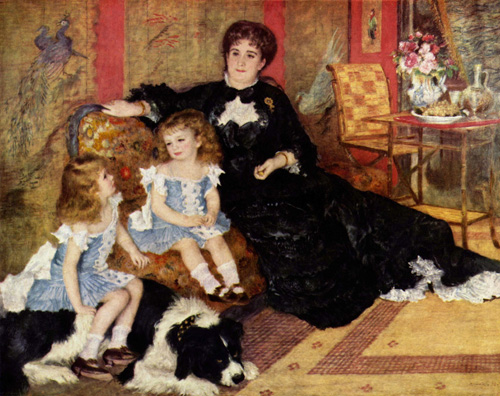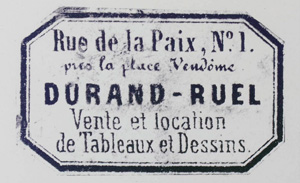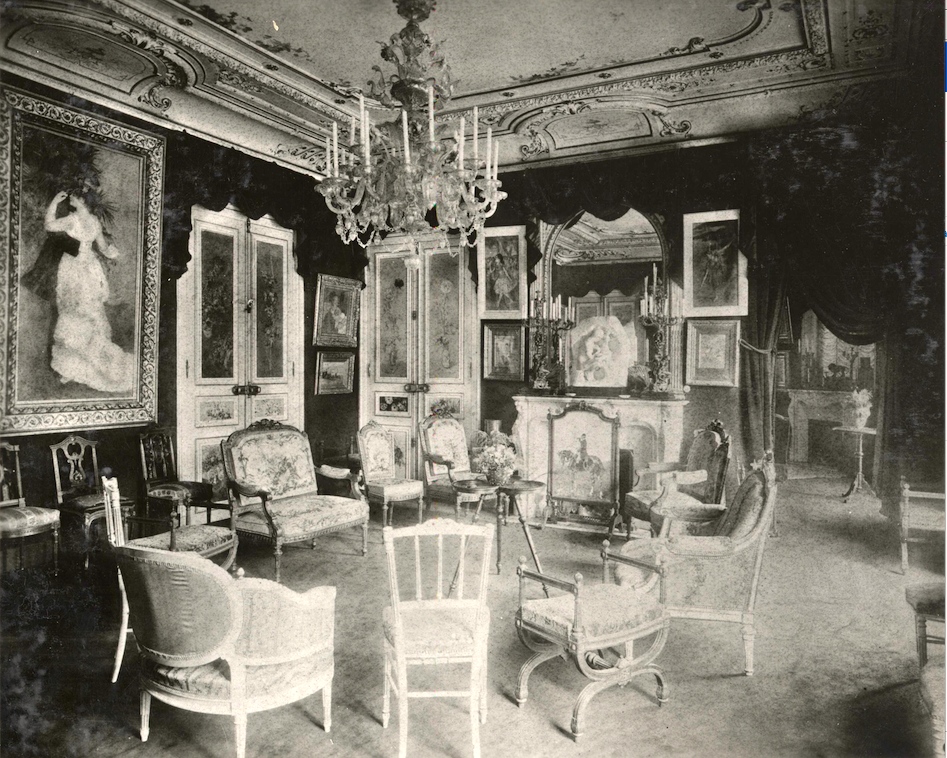From Orlando Figes, The Europeans: Three Livies and the Making of a Cosmopolitan Culture (New York: Metropolitan Books, 2019), pp.383-385
The place where Zola met the
Impressionists most often was at the salon of his publisher, Georges
Charpentier, a keen early patron of the Impressionists. . . Renoir soon
became a
Pierre-Auguste Renoir, Madame Chapentier and her Children
(1878)

regular visitor to the Charpentier's house in
the rue de Grenelle, where he painted the celebrated portrait
Madame Georges Charpentiers et ses enfants
(Madame Georges Charpentiers and her
children) . . .Through Renoir the
Charpentiers began to buy from other Impressionist painters, who often
wrote to them for loans against future sales. In 1879, Charpentier
established the weekly journal La Vie
moderne (Modern
Life) to promote their ideas and help
them financially by paying them for articles. At the instigation of his
wife, whose artistic views were often sought by the Impressionists, he
opened a gallery for them in the Passage des Princes, one of the arcades
built by Haussmann, near the boulevard des Italiens. At the first
exhibition, for Manet, in 1880, a free catalogue was given out to
passers-by in the street, but no paintings sold.
Charpentier’s salon was critical in
getting other patrons to invest in the Impressionists. Many of their
earliest collectors were regulars at his salon . . . or part of the
broader Parisian élite that mixed with that crowd. Still, there were no
more than fifty in Paris. Some were friends of the artists, such as the
composer Emmanuel Chabrier, a friend of Manet and Degas, who depicted
him, the only member of the audience to be seen, in his painting
The Orchestra at the Opéra.
Others were artists themselves, notably the Impressionist painter
Gustave Caillebotte, who inherited a private income of 100,000 francs a
year from his father’s business in military supplies. He not only bought
a lot of the Impressionists’ paintings but lent money to them too. Most
of the early buyers, however, were self-made men – manufacturers,
financiers, professionals, who identified with modern art (it showed the
world in which they lived, right-bank Paris in particular). They had
diverse motives for their purchases: to furnish their mansions with
paintings which they liked; to buy art for speculative purposes; and to
make a statement about their status as major patrons of the arts. . . .
 More than anybody else, it was Durand-Ruel who
enabled the Impressionists to break into the market. Without him, in all
probability, they would not have become widely known and the history of
modern art would have been completely different. In the early 1870s
Durand-Ruel was the only Paris dealer to back the Impressionists. . .
The basic idea of his business plan (which would become common practice
in the modern dealer system) was to buy a large amount of an artist’s
work and raise the value by promoting it. He was the first of a new
breed of art dealers who changed public taste by stimulating interest in
an unknown brand of art, as opposed to the more established practice of
dealing in those works of art which were already known and in demand.
More than anybody else, it was Durand-Ruel who
enabled the Impressionists to break into the market. Without him, in all
probability, they would not have become widely known and the history of
modern art would have been completely different. In the early 1870s
Durand-Ruel was the only Paris dealer to back the Impressionists. . .
The basic idea of his business plan (which would become common practice
in the modern dealer system) was to buy a large amount of an artist’s
work and raise the value by promoting it. He was the first of a new
breed of art dealers who changed public taste by stimulating interest in
an unknown brand of art, as opposed to the more established practice of
dealing in those works of art which were already known and in demand.
Durand-Ruel bought up works by the
Impressionists wholesale, borrowing from bankers, and, if necessary to
corner the market, entering into partnership with other dealers. . .
As
a long-term investor in their work, Durand-Ruel was as much a patron as
a dealer to the Impressionists. He gave them loans and encouragement
when they most needed them. There were times when he came close to
bankruptcy because their paintings did not sell. To raise their value on
the market Durand-Ruel employed a number of innovative strategies
borrowed from investors on the stock exchange. He pushed up the bidding
for his own artists to increase their perceived worth . . . As he had
done with the Barbizon painters, he founded an art review to promote the
Impressionists. He specialized in one-man shows, a practice that became
more common from the 1880s as other dealers learned from his success,
and, instead of hanging paintings in the crowded manner usual at the
time, gave each picture lots of space to emphasize its importance. He
campaigned hard to get their works into public galleries and museums,
recognizing these as “our best publicity”. He loaned their works to
international exhibitions, and built links with agencies and dealers to
develop foreign sales. The art market was internationalized at an ever
growing rate from the 1870s, as cheaper photographic reproductions, the
telegraph and a faster postal system enabled information about new
paintings to cross national frontiers more easily. Durand-Ruel was one
of the first dealers to exploit fully these developments with agencies
in Europe and America. It was in the United States and Russia that
through him the Impressionists would find their biggest markets in the
last two decades of the century.
